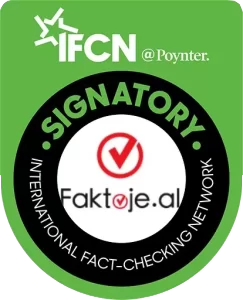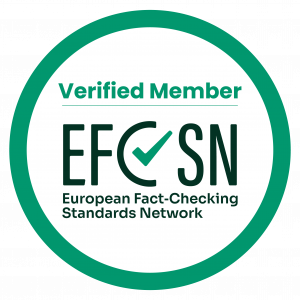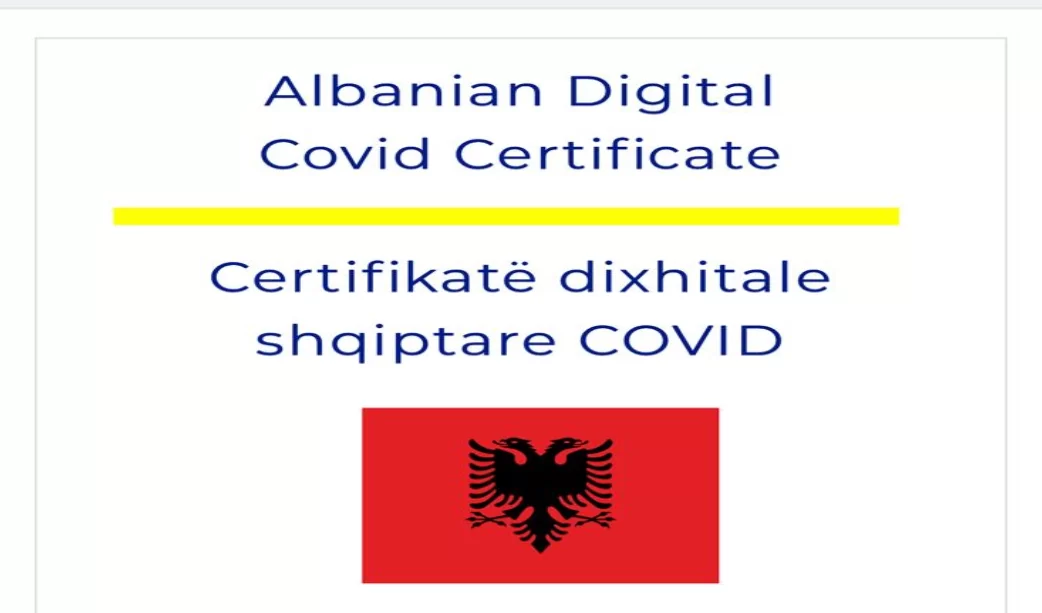Reporting on the tragic murder of a 16-year-old in the serene town of Gramsh by several influential media portals has raised concerns over violations of the Criminal Code for Minors and Journalistic Ethics. According to communication expert Edlira Gjoni, “The media in Albania not only disseminated misinformation but also misled readers about the 16-year-old’s murder due to a lack of factual accuracy, proper knowledge, and adequate evidence to support their reporting.” Additionally, sociologist Gëzim Tushe explains how flawed media representations of social phenomena, particularly crime, contribute to magnifying their impact on society.
Ilda Hoxha
In mid-May, a conflict among adolescents in Gramsh, initiated through social media, ended tragically with the death of a 16-year-old’s life. This incident garnered significant attention in news outlets and various online platforms. One of the portals even headlined: “Killed after a knife conflict, PHOTO of the 15-year-old released.

Source: Bold news
Publishing the name and photo of the victim, especially when they are a minor, constitutes a violation of the Code of Ethics for Journalists and Article 21 of Law 37/2017 for minors.
The stipulations of the violated codes are as follows:
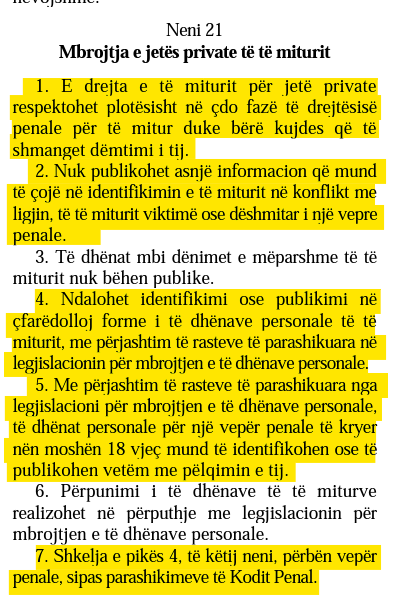
Source: Law No. 37/2017 Juvenile Criminal Justice Code
Article 21
Protection of minors’ privacy
- The right to the private life of minors shall be fully respected at every stage of criminal justice, ensuring their protection from harm.
- No information that may lead to the identification of minors involved in illegal activities, minor victims, or witnesses of criminal offenses shall be published.
- Data on previous punishments of minors shall not be disclosed to the public.
- Identifying or publishing minors’ personal data in any form is strictly prohibited, except in cases specified by legislation for personal data protection.
- With exceptions specified by legislation for personal data protection, personal data related to a criminal offense committed by a person under 18 years old may only be identified or published with their consent.
- Processing of minors’ data shall comply with legislation for personal data protection.
- Violation of paragraph 4 of this article is considered a criminal offense, as per the provisions of the Criminal Code.
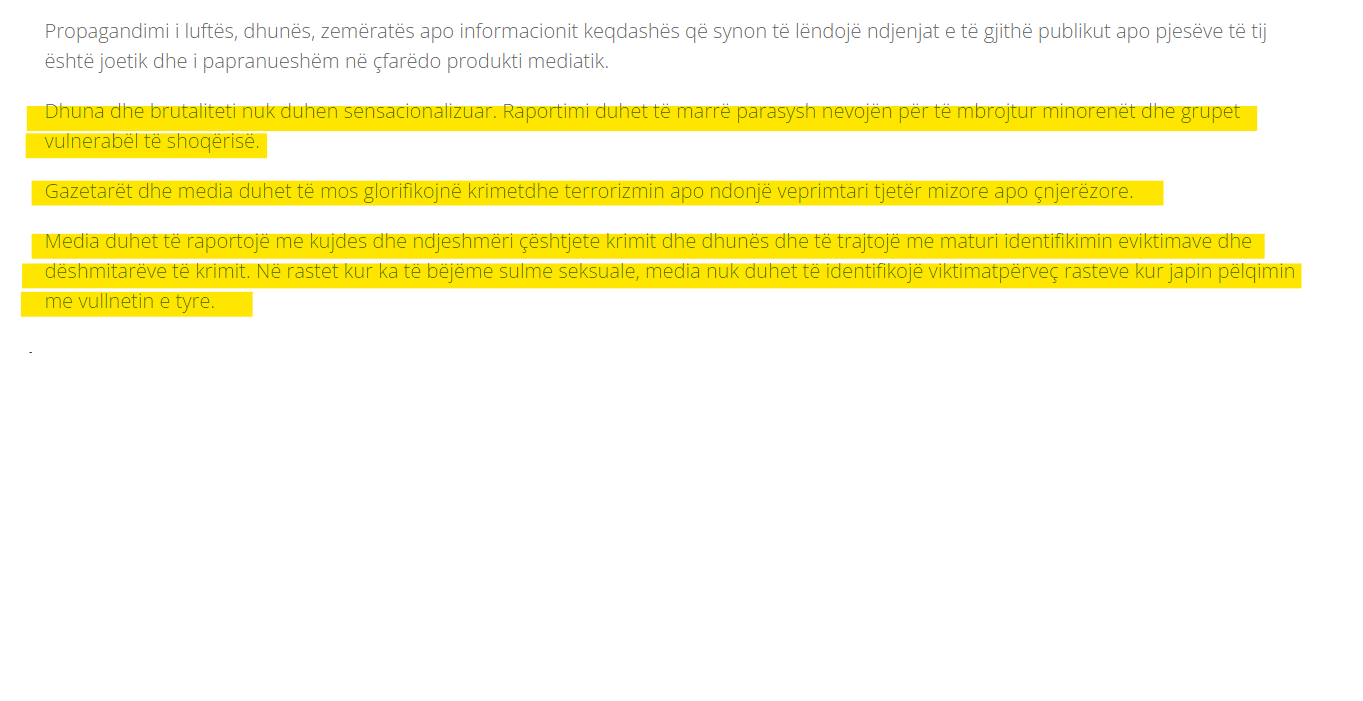
Source: Code of Ethics for Journalists
“Violence and brutality should not be sensationalized. Reporting should prioritize the protection of minors and vulnerable groups in society.
Journalists and media should refrain from glorifying crimes, terrorism, or any other deplorable and inhumane activities.
Media should approach crime and violence-related matters with care and sensitivity, handling the identification of crime victims and witnesses responsibly. Except with voluntary consent, media should not identify victims of sexual assault,” Journalist’s Code of Ethics.
Moreover, the article from the portal lacks an author’s name and refers generally to the media without citing an official source.
Several other online media outlets and their social networks also published photos of the victim and the perpetrator, both being minors, thereby perpetuating the same violations.
We contacted one of the portals via email to address the issue. “Bold News” answered.

Email sent to Bold News.al
Bold News answered:
“In principle it is a mistake. One of our colleagues, took the information from other websites, after seeing the high shares of it. It is definitely unethical and wrong. Thus, we’re open to the idea of correcting this mistake by deleting the part of the news where the photo and identification of the victim appears.
In contrast to the media, the State Police exercised restraint in disseminating information. The official police statement, disclosed the incident without revealing the identities of the individuals involved or the victim, stating, “Specialists for the Investigation of Crimes against Persons, Minors, and Domestic Violence at DVP Elbasan have arrested individuals Xh. Ç., 15 years old, O. Ç., 14 years old, E. K., 15 years old, and S. M., 16 years old,” among other details.
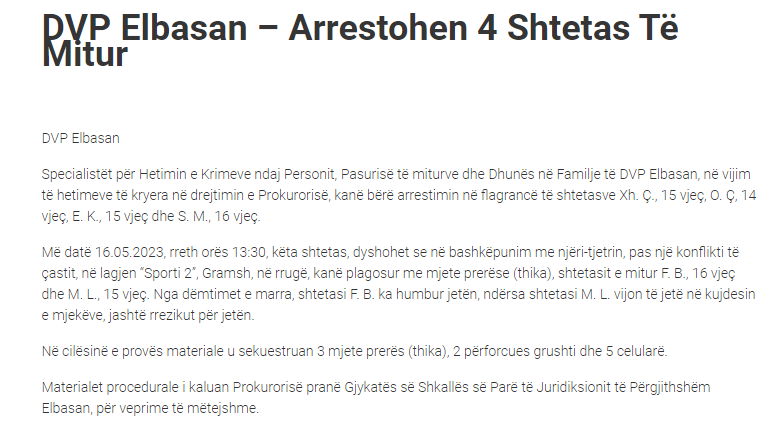
Screenshot of the State Police’s official communication
Edlira Gjoni, a communication expert and journalist, asserts that the headlines and reporting style concerning the murder of the 16-year-old in Gramsh lack ethics and professionalism. “Journalists worldwide are advised to refrain from sensationalism,” she adds..
“The media in Albania not only disseminated misinformation but also misled readers about the 16-year-old’s murder, as they lacked the necessary facts, knowledge, and proper evidence to support their reporting. The extensive reporting was seemingly based on short phone calls or secondary sources.”- said Gjoni.
Apart from the unethical reporting, the narrative surrounding this incident focused heavily on the details of the crime and the labeling of the adolescents involved.
“(Video) How the 15-year-old was killed in Gramsh”
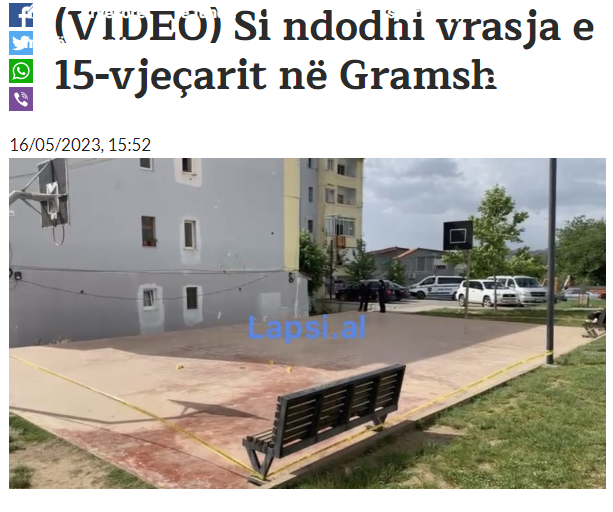
Source: Lapsi.al
“Before the murder, they posted pictures with knives,” reports Jeta Osht Qejf on social networks, attracting thousands of young followers.
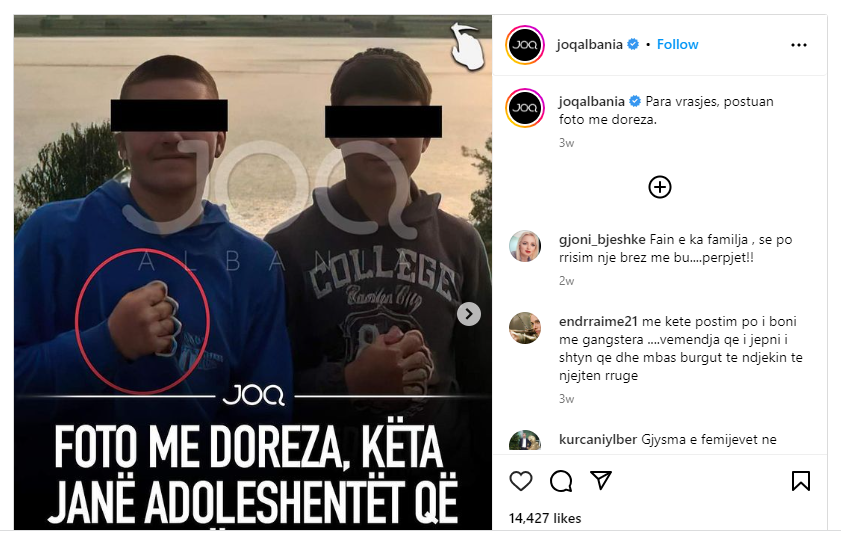
Source: JOQ
Ekspertja e komunikimit Edlira Gjoni rendit pasojat e kësaj qasjeje në raportim:
“The communication expert, Edlira Gjoni, explains the repercussions of this reporting approach “Focusing solely on how the crime occurred and using sensational phrases like “this is how it happened,” “this is how he was killed,” “this is how they attacked him,” deeply impacts the reader’s psyche. Scientifically, such details increase the likelihood of similar events recurring within seven days. The media in Albania concentrates solely on the event’s details, whereas from an educational standpoint, the media should focus on addressing the phenomenon of murder rather than treating it as a manual on ‘how to kill a 16-year-old.'”
Sociologist Gëzim Tushe further highlights that misrepresenting social phenomena, especially crime, contributes to its amplification.
“Crime as an existential phenomenon in Albanian society is expanding and taking on significant proportions.
Sociologists, including Pierre Bourdieu, a French sociologist, widely studied for his insights into the impact of media representation of social phenomena, emphasize that incorrect portrayals magnify crime’s influence tenfold in reality.”
Sociologist Gëzim Tushe further argues that while the media may share some responsibility due to their duty of representation, they also have an ethical responsibility. The manner in which a phenomenon is portrayed should encourage prevention, understanding, and education rather than promoting it.
He points out that detailed portrayals of criminal events not only have emotional effects but also lead to imitation. “If you observe, after a suicide or crime is reported, it often seems like a related event will occur the following day or soon after,” adds sociologist Gëzim Tushe.
Unveiling Insights Following the Tragedy in Gramsh
A journey to Gramsh led us to the “Asllan Shahini” school, where we conversed with the principal regarding the heart-wrenching incident of the 16-year-old student who lost his life at the hands of his classmates. Mrs. Albana Hasa emphasized that the victim met his unfortunate fate just a few meters away from the school he attended. According to Hasa, the conflict that eventually led to the tragic outcome had its roots in a quarrel between the victim and the perpetrators, which originally took place on TikTok.
A teacher at the same school shed light on the pervasive influence of social networks on adolescents, occupying a significant portion of their free time. Moreover, after school hours, many of these youngsters are left without parental supervision.
“I can confidently say that 30% of the students in our school are raised and educated by a single parent, often the mother, as the fathers are compelled to seek work abroad to provide for the family and afford expensive gadgets for their children,” she explained.
Erindi, a 13-year-old student at the Gramsh school, confirmed the prevalent social media engagement among his peers:
“I joined social networks two years ago after witnessing many of my friends and relatives with accounts. Instagram and TikTok are particularly popular among us youth. Some time back, there was a challenge that involved driving a car at speeds of up to 300 km/h. There are other risky trends we try to be part of,” the teenager shared.
Juna, a 10-year-old fourth-grade student, spends a considerable portion of her day alone at home, with her mother at work and her father in Greece, working to support the family. Juna disclosed that she spends her time on the internet and, naturally, has her own set of social media accounts.
“During the afternoons, I’m home alone. I have a phone to communicate with my friends and play games online, particularly Roblox,” the 10-year-old shared.
The President of the Social Workers’ Union, Mirgit Vataj, expressed alarm over the high incidence of conflicts originating on social media platforms.
“Based on observations, including those conducted by myself, TikTok appears to be the platform with a concerning prevalence of hate speech, violence, and cyberbullying against children, exposing them to inappropriate content. Parents should actively monitor and engage in conversations with their teenagers to prevent such cases,” Mirgit Vataj urged.


